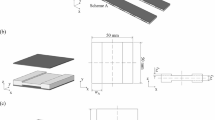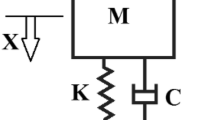Abstract
This paper presents the development of an AA battery size electromagnetic vibration energy harvester with an aim to maximize the output power density. A tube shape and stacked opposing permanent magnets with magnetic spring were used to suit the shape constraint as well as to achieve high flux linkages. An initial prototype of electromagnetic vibration harvester with AA battery size was built and tested on a controllable shaker to obtain its output voltage and power level at different frequencies for fixed accelerations. A single magnet was fixed at the bottom of the harvester to provide levitation force in this development in order to lower the resonant frequency. A special time-domain based analytical model was also developed using both Finite Element Analysis and Simulink simulation. The time-domain analytical model is easier to implement than other frequency domain based analytical models which generally applied in literatures for modelling of the electromagnetic vibration energy harvesters. The analytical model was verified by the measured results obtained from the initial prototype. The validated analytical model was successfully applied to optimize the harvester. Two more generator prototypes were further built and tested after the optimization study. The optimized harvester using three stacked opposing permanent magnets could achieve a normalized power density of 12,655 μWcm−3 g−2 at 9.9 Hz frequency with 0.22 g acceleration, which is significantly higher than other reported electromagnetic vibration energy harvesters.





















Similar content being viewed by others
References
Wang Y, Zhang Q, Zhao L, Kim ES (2017) Non-resonant electromagnetic broad-band vibration-energy harvester based on self-assembled ferrofluid liquid bearing. J MEMS 4:809–819
Gutierrez M et al (2015) Design and characterization of a low frequency 2-dimensional magnetic levitation kinetic energy harvester. Sens Actuators A Phys 236:1–10
Berdy DF, Valentino DJ, Peroulis D (2014) Design and optimization of a magnetically sprung block magnet vibration energy harvester. Sens Actuators A Phys 218:69–79
Saha CR et al (2008) Electromagnetic generator for harvesting energy from human motion. Sens Actuators A 1:248–253
Saha CR et al (2006) Optimization of an electromagnetic energy harvesting device. IEEE Trans Magn 10:3509–3511
Halim MA, Kim DH, Park JY (2016) Low frequency vibration energy harvester using stopper-engaged dynamic magnifier for increased power and wide bandwidth. J Electr Eng Technology 3:707–714
Khan FU, Iqbal M (2018) Electromagnetic bridge energy harvester utilizing bridge’s vibrations and ambient wind for wireless sensor node application. J Sens 1–18
Khan FU, Ahmad I (2016) Review of energy harvesters utilizing bridge vibrations. Shock Vib 1–21
Halim MA et al (2016) A miniaturized electromagnetic vibration energy harvester using flux-guided magnet stacks for human-body-induced motion. Sens Actuators A Phys 249:23–31
Kurt E, Kale MM, Akbaba S, Bizon N (2018) Analytical and experimental studies on a new linear energy harvester. Can J Phys 96:727–7330
Wang W et al (2017) Magnetic-spring based energy harvesting from human motions: design, modeling and experiments. Energy Convers Manag 132:189–197
Chae SH et al (2017) Electromagnetic linear vibration energy harvester using sliding permanent magnet array and ferrofluid as a lubricant. Micromachines-Basel 10:288
Drezet C, Kacem N, Bouhaddi N (2018) Design of a nonlinear energy harvester based on high static low dynamic stiffness for low frequency random vibrations. Sens Actuators A Phys 283:54–64
Sun K, Liu G, Xu X, Hou ZX (2012) Nonlinear resonant generator for harvesting energy from human wrist vertical shaking. Appl Mech Mater 128–129:923–927
Shirvanimoghaddam M et al (2019) Towards a green and self-powered internet of things using piezoelectric energy harvesting. IEEE Access 7:94533–94556
Khaligh A, Zeng P, Zheng C (2010) Kinetic energy harvesting using piezoelectric and electromagnetic technologies-state of the art. IEEE Trans Ind Electron 3:850–860
Xia H, Xia Y, Ye Y, Qian L, Shi G, Chen R (2018) Analysis and simulation of synchronous electric charge partial extraction technique for efficient piezoelectric energy harvesting. IEEE Sens J 15:6235–6244
Roundy S, Zhang Y (2005) Toward self-tuning adaptive vibration based micro-generators. In: AlSarawi SF (ed) Proceedings of the society of photo-optical instrumentation engineers (SPIE), vol 5649. pp 373–384
Wu Z et al (2020) Largely enhanced electrostatic generator based on a bipolar electret charged by patterned contact micro-discharge and optimized substrates. Nano Energy 71:104602
Zhang Y et al (2018) Micro electrostatic energy harvester with both broad bandwidth and high normalized power density. Appl Energ 212:362–371
Sadowski S, Spachos P (2018) Solar-powered smart agricultural monitoring system using internet of things devices
Tang S et al (2012) Smartmote: energy and voi aware solar-powered sensor network design for environment monitoring
Wang C et al (2018) Combining solar energy harvesting with wireless charging for hybrid wireless sensor networks. IEEE Trans Mob Comput 3:560–576
Wang Y et al (2019) Flexible thermoelectric materials and generators: challenges and innovations. Adv Mater 31:180791629
Guo X et al (2020) A new hybrid system composed of high-temperature proton exchange fuel cell and two-stage thermoelectric generator with Thomson effect: energy and exergy analyses. Energy 195:117000
Saha CR, Donnell TO, Wang N, McCloskey P (2008) Electromagnetic generator for harvesting energy from human motion. Sens Actuators A 1:248–253
Wu S et al (2017) An electromagnetic wearable 3-DoF resonance human body motion energy harvester using ferrofluid as a lubricant. Appl Energy 197:364–374
Pan Y et al (2019) Modeling and field-test of a compact electromagnetic energy harvester for railroad transportation. Appl Energy 247:309–321
Lin T et al (2018) Modeling and field testing of an electromagnetic energy harvester for rail tracks with anchorless mounting. Appl Energy 213:219–226
Wang S, Ke Y, Huang P, Hsieh P (2018) Electromagnetic energy harvester interface design for wearable application. IEEE Trans Circ-II 5SI 65:667–671
Green PL et al (2013) On the identification and modelling of friction in a randomly excited energy harvester. J Sound Vib 19:4696–4708
http://www.industrycortex.com/datasheets/profile/1001410661, VEH-460
Funding
Partial financial support from General Scientific Research Project from Zhejiang Department of Education (Grant No. Y201942330) and Zhejiang Provincial Natural Science Foundation [Grant No. LD21F040001].
Author information
Authors and Affiliations
Contributions
All authors contributed to the study conception and design. Material preparation, data collection and analysis were performed by HL and NW. The first draft of the manuscript was written by HL and NW, and all authors commented on previous versions of the manuscript. All authors read and approved the final manuscript.
Corresponding authors
Ethics declarations
Conflict of interest
The authors have no conflicts of interest to declare that are relevant to the content of this article.
Data Availability
All authors confirm that all data and materials support the published claims and comply with field standards.
Additional information
Publisher's Note
Springer Nature remains neutral with regard to jurisdictional claims in published maps and institutional affiliations.
Rights and permissions
About this article
Cite this article
Liao, H., Ye, T., Pang, Y. et al. Modelling and Optimization of a Magnetic Spring Based Electromagnetic Vibration Energy Harvester. J. Electr. Eng. Technol. 17, 463–474 (2022). https://doi.org/10.1007/s42835-021-00904-4
Received:
Revised:
Accepted:
Published:
Issue Date:
DOI: https://doi.org/10.1007/s42835-021-00904-4




